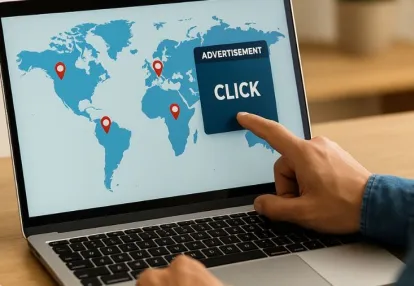
Our spy tools monitor millions of popup and pop-under from over 90+ countries and thousands of publishers.
Get StartedPop advertising, a term synonymous with the digital advertising landscape, has undergone a significant transformation since its inception. Initially designed as pop-up windows that interrupt a user's browsing experience, these ads have been both a source of annoyance and an effective marketing tool. Their purpose is to capture attention and deliver targeted messages through spontaneous ad displays that "pop up" onscreen.
The history of pop advertising is a story of change and adaptation. It started as a controversial method that irritated users but has now become a more user-friendly format. Instead of being seen as mere interruptions, pop ads have evolved into sophisticated strategies that aim to provide value and relevance to the audience.
In the early days, pop ads were notorious for their intrusive nature. They would appear suddenly, often blocking the content that users were trying to view. This aggressive approach led to widespread frustration and gave rise to the use of ad blockers.
However, over time, advertisers began to realize the importance of respecting the user experience. They understood that bombarding people with unwanted ads would only push them away. To stay effective in this changing landscape, pop advertising had to adapt.
Today's pop ads are a far cry from their predecessors. Instead of forcefully interrupting users, they are designed to blend seamlessly with the website or app they appear on. These native pop ads are less obtrusive and more likely to be accepted by users.
By incorporating these elements, advertisers can create pop ads that not only grab attention but also provide a positive user experience. This shift towards user-friendly pop ads has been facilitated by the rise of Pop Ads, which allows marketers to seamlessly integrate their messages into the user's browsing experience while maintaining relevance and non-disruptiveness.
The transformation of pop advertising is not just about changing ad formats; it also reflects a broader shift in consumer attitudes. As people become more accustomed to online advertising, their tolerance for interruptions decreases. They expect ads to be relevant, helpful, and respectful of their time and attention.
This change in mindset has forced advertisers to rethink their approach. Instead of relying solely on intrusive tactics, they are now focusing on creating meaningful connections with their audience. Pop ads, when used strategically and responsibly, can play a role in this new era of advertising.
As an advertiser, it's essential to understand the evolution of pop advertising and how it aligns with the changing needs of consumers. Here are some key takeaways:
Pop-up ads, a term that many internet users dislike, were created out of cleverness and necessity. Ethan Zuckerman, while working at Tripod.com, is credited with inventing pop-up ads as a way to make money from content in the fast-changing digital world.
Zuckerman's idea quickly became popular. Website owners liked this new type of advertising because it grabbed attention and brought in money. Before long, pop-up ads were everywhere on the internet, changing from something new into a common symbol of online advertising.
But despite their initial success and widespread use as a way to make money, pop-up ads had problems too. Users found these annoying ads bothersome, interrupting what they were doing online and making their experience worse. This annoyance with pop-up ads was the start of ad blockers becoming popular.
To deal with the growing annoyance caused by intrusive pop-ups, clever software developers started making tools that let users control their browsing experience. These tools, called ad blockers, gave users the power to stop unwanted pop-ups from showing up on their screens.
Ad blockers work by finding scripts related to ads and stopping them from running. This means users can browse without annoying interruptions. The rise of ad blockers changed how people dealt with online advertising, making the once-effective pop-up ad strategy less powerful.
The widespread use of ad blockers showed advertisers that users didn't want intrusive ads anymore. This made everyone in the industry think about better ways to reach audiences without ruining their online experience.
This section has explained how pop advertising changed in its early days, talking about the controversial start of pop-up ads, how well they worked at first, and then how ad blockers became popular because users didn't like them. From now on, we'll look at how these early experiences with pop advertising have influenced its development and made its strategies more varied.
The world of digital marketing has changed as advertisers have started using less annoying Interstitial ads. These new strategies are created to grab user attention without causing any disturbance, leading to a more interesting online experience. Now, the focus is on using pop-ups for lead generation, increasing website traffic, and boosting sales and subscriptions.
Exit-intent overlays are a better alternative to traditional pop-up ads that often ruin the user experience. This technology detects when a user is about to leave a page and shows them an interesting message or offer. The timing is crucial—it happens just as the user's engagement is ending, which minimizes disturbance and maximizes the chance of conversion.
Time-triggered modals are another clever tactic that takes advantage of when users are most engaged. By setting these pop-ups to appear after a user has spent a certain amount of time on a page, it ensures that only interested visitors receive these prompts.
Helping with digital storytelling, scroll-based pop-ups show up as users scroll through content, providing extra narrative layers or relevant calls-to-action based on what they're currently reading.
By using these improved advertising methods, businesses can maintain effective communication channels with their audiences without hurting the online experience. Each approach has its own benefits while together they show an industry working towards balancing commercial goals and consumer satisfaction. In the future, this balance will continue to be key for innovative pop advertising strategies.
A look at advertising history reveals how pop advertising has evolved alongside advertising as a whole. The methods used by ancient civilizations may seem basic compared to today's complex digital strategies, but they share common principles.
One of the earliest forms of advertising can be traced back to ancient Egypt, where carvings were used to display laws and treaties. This highlights the importance of sharing information with a specific audience, which remains a key aspect of pop advertising today.
In 1472, print ads were introduced, allowing businesses to reach a larger audience. This medium was ideal for visual content and played a significant role in the early days of pop advertising, where eye-catching visuals were crucial for grabbing attention.
During the "Golden Age of Advertising," there was a shift towards radio and TV ads. Advertisers began creating personalized advertisements that resonated with consumers on an emotional level. This shift towards user-centered experiences can also be seen in modern pop advertising.
The true game-changer in advertising was the rise of online advertising. With the ability to gather vast amounts of user data, advertisers could now target specific audiences and deliver personalized messages. This paved the way for innovative strategies like pop advertising.
An important development in online advertising was the introduction of display ads. These graphical ads proved to be highly effective in grabbing attention, as demonstrated by the famous AT&T banner ad in 1994. Its success established online advertising as a profitable industry and encouraged further experimentation with digital marketing techniques like pop advertising.
Another significant milestone was Yahoo's implementation of keyword-based ads. By allowing advertisers to target users based on their search queries, Yahoo made ads more relevant to individual interests. This focus on relevance is a key principle in pop advertising, where timely and contextually appropriate messages can engage users without disrupting their online experience.
With the rise of smartphones and other smart devices, a new era of advertising has emerged — mobile advertising. Advertisers now face the challenge of adapting their strategies to suit the unique habits and preferences of mobile users. This presents both obstacles and possibilities for pop advertising.
As we can see from this journey through advertising history, pop advertising has evolved alongside technological advancements and changing consumer behaviors. It continues to be shaped by these factors as advertisers seek innovative ways to connect with their target audiences.
As smartphones began to dominate the market, pop advertising had to evolve once again. This digital revolution gave birth to a new era of mobile advertising, one where responsive pop-up designs and location-based targeting features became the new norm.
The history of pop advertising is as diverse as the overall history of advertising itself. From ancient Egyptian carvings to print ads, radio/TV ads, and online advertising, each change brought an opportunity for marketers to connect with audiences in more meaningful ways.
Just like the iconic AT&T banner ad that marked a crucial moment in display advertising, mobile ads offered advertisers an unprecedented level of closeness with their audience. By exploring this history of pop advertising principles from ancient visual storytelling to modern digital techniques, we can better understand the evolution of this powerful marketing tool.
Throughout history, humans have used visuals to convey messages and stories. From cave paintings to hieroglyphics, images have been a fundamental way of communication. In a similar manner, pop-up ads leverage eye-catching visuals to grab attention and deliver messages effectively.
With the invention of the printing press in the 15th century, mass communication became possible. Newspapers and magazines were filled with advertisements, allowing businesses to reach a wider audience. Pop-up ads took inspiration from this format by appearing suddenly on websites, demanding immediate attention.
The advent of radio and television brought audio and visual elements together in advertising. Jingles, catchy slogans, and memorable characters became synonymous with brands. Similarly, pop-up ads utilize multimedia content such as videos and animations to engage users visually and audibly.
As the internet gained popularity in the late 20th century, online advertising emerged as a game-changer. Banner ads and pop-ups flooded websites, often lacking relevance to users. However, advancements in technology allowed for more sophisticated targeting methods, leading to the rise of contextual and behavioral advertising.
Consider Yahoo's introduction of keyword-based ads. This innovative strategy allowed advertisers to target specific users based on their search behavior, making ads more relevant and effective. In a similar vein, location-based targeting features in mobile pop-ups allow businesses to deliver highly personalized messages to users based on their geographic location.
This shift towards mobile consumption habits has not been without its challenges. Yet, the industry continues to adapt and innovate, ensuring that pop advertising remains a key player in our digital landscape.
As smartphones became an integral part of our daily lives, mobile advertising took center stage. With features such as push notifications and in-app ads, brands could reach consumers directly on their devices. This level of proximity created new opportunities for personalized marketing experiences.
While pop advertising has come a long way, its future success hinges on finding the right balance between user experience and brand objectives. Consumers are becoming increasingly selective about the content they engage with, making it essential for marketers to deliver value through their pop-up ads.
As technology continues to evolve and consumer behaviors shift, pop advertising will undoubtedly undergo further transformations. By staying agile and embracing these changes, brands can leverage the power of pop-ups to connect with their target audience in meaningful ways.
The shift in the digital space has brought new challenges to advertisers. One of the most pressing is the declining trust in online advertising. Ad blockers, a direct response to intrusive and irrelevant ads, have become a common tool among internet users. In fact, ad-blocking practices cost publishers $22 billion in 2015 alone.
So how can advertisers navigate this landscape of skepticism and avoidance? It's all about balance - between personalization and privacy, between providing value and respecting user boundaries.
User-centered design plays a pivotal role in creating pop ads that are effective without being obnoxious. This approach involves understanding the user's needs, preferences, and behaviors to create an ad experience that feels intuitive and natural.
Several companies have successfully implemented these principles into their pop ad campaigns.
A leading e-commerce platform introduced time-sensitive pop-ups offering discounts on items that users had viewed but not purchased. The results? An increase in sales, positive customer feedback, and no significant rise in ad blocker usage.
A popular news website used user-generated content (UGC) in their pop-ups. Readers who contributed content were offered exclusive access to premium articles. This strategy boosted engagement rates by making users feel valued and involved.
In sum, the key to modern pop advertising lies in understanding your audience and respecting their online space. As we move forward, it's crucial to embrace a user-first approach, leveraging personalization, privacy, and design to create pop ads that provide value without causing annoyance.
The acceptance of pop advertising depends on creating a mutually beneficial relationship between advertisers and audiences. This means adopting practices that prioritize the user’s experience above all else. Here are some key considerations for responsible pop ad practices:
Users should always know what kind of data is being collected and how it's used. Getting clear permission not only follows privacy rules but also builds trust.
Pop-ups should offer something valuable to the audience. Whether it's helpful content, exclusive deals, or personalized suggestions, users are more open to ads when they get something in return.
Nobody likes intrusive ads that interrupt their browsing. Showing ads at the right time and not too often can actually improve the user's experience instead of ruining it.
Pop ads should blend in with the website's design, looking like a natural part of the page on any device. This way, they won't be annoying or distracting to users.
Instead of just showing static ads, why not make them interactive? This could be through quizzes, polls, or mini-games that users can actively participate in. It makes the ad more engaging and less passive.
By following these practices, advertisers can make sure that pop advertising continues to work well. As users become more careful about their online experiences, advertisers who meet these expectations will have an advantage in the long run. The goal is to create ads that people actually enjoy seeing and even interact with willingly – turning what used to be an annoyance into a welcome part of their online routine.
The evolution of pop advertising has been a journey full of challenges, innovation, and adaptation. It started out as a necessary response to the fast-paced digital world but quickly became a source of annoyance for internet users. However, thanks to advancements in technology and a shift towards user-centered design, pop-up ads have transformed into less intrusive interstitials that serve both marketing purposes and user needs.
Throughout its history, pop advertising has shown its ability to change based on what users want. It has gone from aggressive full-page overlays to targeted modals that appear based on user actions. This constant evolution is a clear indication that advertisers are listening to feedback and making improvements.
The fact that pop advertising is now more widely accepted is not a coincidence. It shows that advertisers have learned from their past mistakes and are committed to finding a balance between promoting their products/services and providing a positive browsing experience.
However, this doesn't mean that pop advertising has reached its final form. As technology continues to advance and privacy concerns grow, advertisers will need to find new ways to personalize their messages without being intrusive. Pop Ads could be the answer. By seamlessly integrating ads into the user's browsing experience, native advertising offers a way to deliver personalized messages without being overly disruptive. The key to success in the future will be putting users first and focusing on creating meaningful interactions rather than just grabbing attention momentarily.
Receive top converting landing pages in your inbox every week from us.
Tips & Tricks
Expanding your pop ad campaigns globally requires the right geo-targeting strategies. Explore five proven approaches to scaling pop ads across different regions while maintaining strong performance. Learn how to adapt creatives, timing, and messaging to match local audiences and cultural nuances. Perfect for advertisers ready to take their pop campaigns to an international level with confidence.
David Kim
7 minDec 11, 2025
How-To
Turn lost opportunities into sales with effective holiday remarketing using push ads. Learn how to re-engage shoppers who abandoned their carts through timely, personalized notifications. Discover proven strategies for crafting irresistible messages that drive action and recover revenue. Perfect for marketers aiming to boost conversions and maximize holiday season profits.
Elena Morales
7 minDec 10, 2025
How-To
AI is transforming the way advertisers approach pop campaigns in 2025. Discover how automation, predictive analytics, and real-time optimization can enhance targeting and boost engagement. Learn practical tips for creating smarter, high-performing pop ads that deliver measurable results. Perfect for marketers ready to stay ahead in the evolving world of AI-driven advertising.
Priya Kapoor
7 minDec 8, 2025




